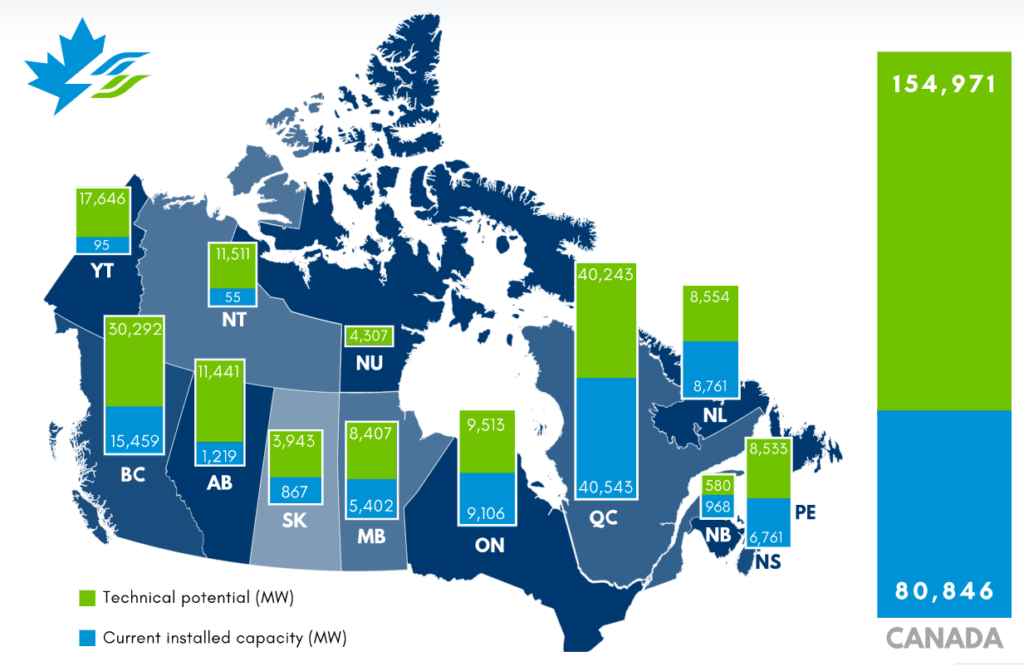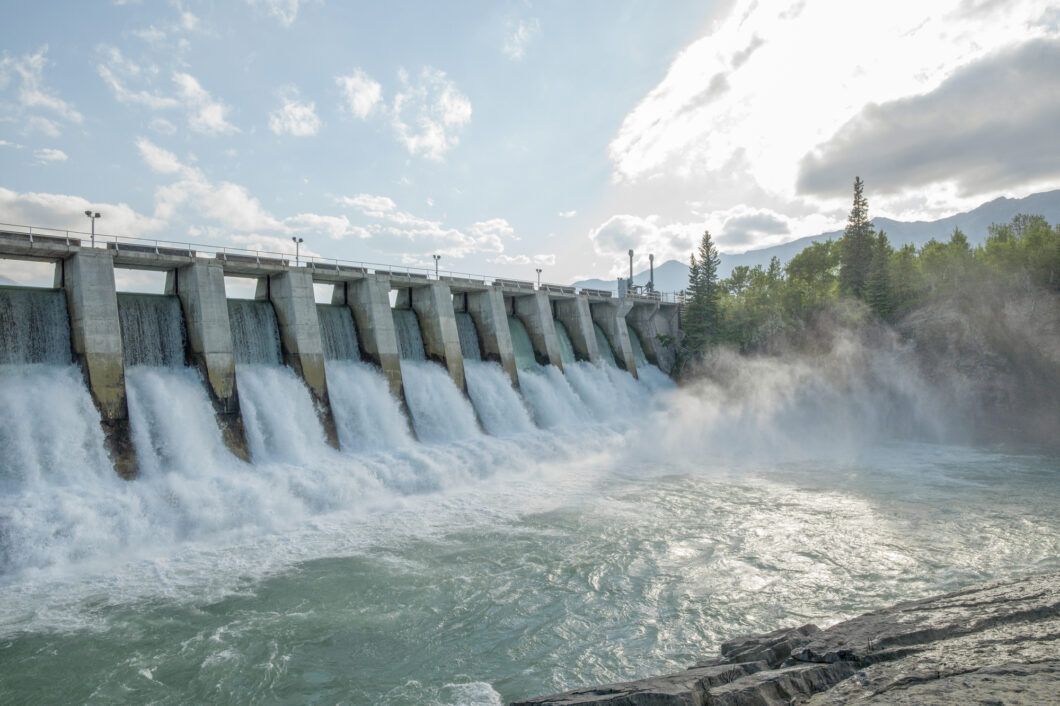Waterpower, also known as hydropower, is one of the oldest and most reliable renewable energy sources in the world. By harnessing the kinetic energy from flowing or falling water, waterpower generates electricity in a clean and sustainable way. Let’s dive into what waterpower is, why it’s essential, and how it supports Canada’s energy future.
What is Waterpower?
Water exists in various forms on Earth – ice, fresh water, saline water, and atmospheric water – and is constantly moving through the water cycle (evaporation, condensation, precipitation, infiltration, surface runoff, and subsurface flow). Waterpower works by capturing the energy from falling or flowing water and converting it into mechanical energy, which is then transformed into electrical energy (or “hydroelectricity”).
In Canada, most of our hydroelectricity is generated through two main methods:
- Run-of-River: Water flows directly from a river into a penstock (a pipe that leads water to the turbine), generating electricity without the need for storage.
- Reservoir generating stations: Water is stored behind a dam in a reservoir. When needed, it is released, converting its potential energy into kinetic energy as it flows down the penstock and powers a turbine.
Another variation, pumped storage, involves storing water in an elevated reservoir. When demand for electricity rises, water is released to generate power. These methods make waterpower incredibly flexible, reliable, and capable of meeting energy needs on demand.
Why Waterpower?
1. Sustainable and Renewable
Waterpower is a sustainable energy resource because it is renewable – meaning the process of generating power is replenished naturally at a rate equal to or faster than its consumption. Importantly, water is not consumed, depleted, or wasted in the process, making it one of the most environmentally-friendly sources of electricity available.
2. Canada’s Clean Energy Advantage
Canada is a global leader in waterpower. Hydropower provides over 60% of the country’s total electricity, making it Canada’s most abundant source of clean, renewable energy. With an installed capacity exceeding 82,000 MW and the potential to expand further, waterpower is essential to meeting the country’s growing energy demands while reducing greenhouse gas emissions.

3. Waterpower: The Backbone of a Clean, Reliable Electricity Grid
Waterpower is unique in that it’s the only renewable energy source that can provide baseload electricity, meaning it delivers a constant, reliable supply of power. Additionally, waterpower facilities can store energy in reservoirs, providing long-term energy storage that supports grid stability. This makes waterpower essential for balancing other renewable sources like wind and solar, which can be intermittent.
In Canada’s evolving energy landscape, waterpower is central to achieving clean electrification, where fossil fuel consumption is replaced with electricity generated from renewable sources. Hydropower is one of the lowest-emitting forms of electricity, making it critical to achieving Canada’s decarbonization goals.
4. Economic Benefits
Hydropower is a cornerstone of Canada’s economy, generating at least $35 billion in GDP and supporting over 130,000 jobs across the country. Provinces with abundant hydropower resources often have the lowest electricity costs, helping to keep energy affordable for consumers.
Canada also exports a significant amount of clean electricity to the U.S., with hydropower accounting for about 80% of these exports. In regions such as New York, New England, and the Pacific Northwest, Canadian hydropower is a vital source of clean energy.
Water stewardship and care for the environment
Waterpower not only plays a crucial role in providing clean and renewable energy, but it also highlights the importance of responsible water stewardship. As we harness the power of water to generate electricity, it is vital to ensure that water resources are managed sustainably and responsibly. In Canada, hydropower companies work closely with local communities, Indigenous groups, and environmental consultants to manage water resources responsibly. This includes maintaining healthy river ecosystems, preventing the depletion of water supplies, and monitoring the impacts of hydroelectric projects on local wildlife and habitats. Through adaptive management practices, the hydropower industry seeks to minimize environmental disruptions while maximizing the benefits of clean energy production.
Waterpower projects are increasingly being designed with environmental considerations in mind, including fish-friendly turbines, wildlife habitat restoration, and the careful management of water flows to ensure the continued health of aquatic ecosystems. In this way, waterpower contributes not only to Canada’s energy needs but also to a broader commitment to water conservation, environmental protection, and sustainable development.
Waterpower: a long-term investment
One of the remarkable features of waterpower is its longevity. Some of Canada’s hydropower facilities have been in operation for more than 100 years and can continue to generate electricity for generations to come with proper maintenance and upgrades. In fact, most waterpower projects are built to last over 100 years, making them a highly cost-effective energy solution in the long term.
Facts & Figures
- No air pollutants: Waterpower generates electricity with zero air pollution, making it one of the cleanest energy sources available.
- Ultra-low greenhouse gas emissions: Waterpower has one of the lowest life-cycle greenhouse gas emissions of any energy resource.
- Most efficient: Hydropower is the most efficient form of electricity generation, converting over 90% of available energy from water into electricity. In comparison, fossil fuel power plants operate at approximately 60% efficiency.
- Capacity: Canada has 550+ hydropower facilities, with an installed capacity of over 82,000 MW, producing over 385 TWh of electricity annually – more than 60% of the country’s total electricity generation.
- Economic impact: The hydropower sector supports nearly 49,000 jobs in Canada and contributes significantly to the economy.
The Cost Advantage
Hydropower is not only an environmentally-friendly energy source, but it is also one of the most cost-effective options available. Provinces with the greatest access to hydropower have some of the lowest electricity rates in the country. In Quebec, where 94% of electricity comes from hydropower, the grid is both the cleanest and most affordable in the country. For a typical household consuming 1,000 kWh per month, this translates to an average monthly bill of approximately $80 – significantly lower than in cities like Toronto, where the same usage costs about $151. As energy demand grows, hydropower’s flexibility and reliability position it as a key solution for a sustainable energy future.
The Future of Waterpower in Canada
Canada’s vast, untapped waterpower potential offers significant opportunities for growth. With more than 150,000 MW of undeveloped waterpower resources, Canada could more than double its current hydropower capacity, contributing to both domestic energy needs and international clean energy goals.
Waterpower is more than just an energy source – it’s a vital part of Canada’s clean, reliable, and sustainable energy future. From powering our homes and businesses to supporting economic growth and reducing emissions, waterpower will continue to play a central role in Canada’s energy transition for generations to come.

